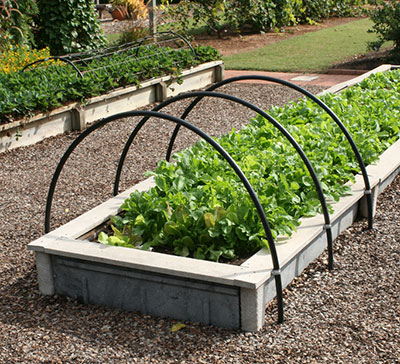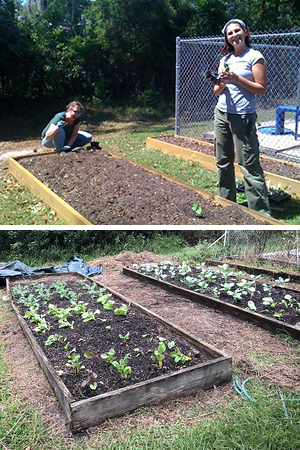Raised Beds: Benefits and Maintenance
 Vegetable gardening is a great way to grow your own food and live a more sustainable lifestyle. Unfortunately, Florida's soils don't always lend themselves to growing vegetables. If this is true of your landscape, try gardening in raised beds instead! This gardening technique raise yields and reduce maintenance in your vegetable garden.
Vegetable gardening is a great way to grow your own food and live a more sustainable lifestyle. Unfortunately, Florida's soils don't always lend themselves to growing vegetables. If this is true of your landscape, try gardening in raised beds instead! This gardening technique raise yields and reduce maintenance in your vegetable garden.
What are raised beds?
Raised beds are freestanding garden beds constructed above ground level. "Raised" means that the soil level in the bed is higher than the surrounding soil. The word "bed" implies a size small enough to work in without actually stepping onto planting area. Often raised beds are enclosed with box-like frames to provide structural support and prevent erosion.
Frames for raised beds can be constructed using a variety of materials, including brick, rot-resistant lumber, landscape timbers, or concrete blocks. Beds can also be elevated for gardeners who want to avoid bending to the ground while working.
Benefits
Besides being aesthetically pleasing, raised vegetable beds offer many benefits to gardeners. Here are a few:
Improved Soil Conditions — Florida soils tend to be sandy and low in organic materials. By adding garden soil, compost, and soilless media to your raised bed, you can keep the soil full of the nutrients plants need. Since you don't walk in raised beds, soil compaction is also reduced. This allows water and air to move more freely through the soil.
Higher Yields — Raised-bed vegetables can be planted at higher densities, just far enough apart to avoid crowding but close enough to shade out weeds. The result is more produce per square foot. If your raised bed is elevated above the ground, you'll also have fewer problems with nematodes. These microscopic worms wreak havoc on a plant's roots and reduce yields.
Enhanced Accessibility — Raised beds offer options to gardeners with decreased mobility. Because the soil level is higher, you stoop less to weed, water, and do other garden chores. Elevating the raised beds one to three feet high makes gardening possible for people with limited mobility. Make sure you have wide, hard-surfaced paths in between beds to provide safe access for walkers and wheelchairs.
Decreased Maintenance — Since vegetables are planted much closer together than they would be in a traditional bed, they can shade out much of the weed growth. Pest control is also easier with raised beds. If burrowing rodents like moles are a problem, the bottom of the bed can be lined with poultry wire or hardware cloth. You can even cover beds with bird netting. The narrow dimensions of the beds make it easy to add an overhead frame. The frame can also be used to support covers for frost or freeze protection.
Water Conservation — Raised beds can be irrigated using canvas soaker hoses, perforated plastic sprinkle hoses, or low-volume drip tubing. These irrigation methods work well for dispersing water in the long, narrow beds. They also reduce disease by directing water to the soil instead of wetting leaf surfaces with overhead irrigation.
There is one caution to building raised beds, however. Products and building materials used for ornamental plants may not be suitable for edibles. Be cautious of recycled lumber as a building material. Please also remember that not all pesticides are safe for vegetable gardens. Many of the products you would normally use in ornamental beds can be dangerous when used on edible crops. Always read and follow the instructions on the label; it's the law.
What to Plant in Raised Beds
Most garden vegetables will grow well in raised beds. Try growing lettuce, greens, radishes, and strawberries. Bush type vegetables, such as tomatoes, cucumbers, and beans also do well in raised beds. You can install trellises for vegetables that need support, like some tomatoes and beans. Certain crops, like squash, melons, and sweet corn, usually do better in the ground because they require more space than other vegetables.
If you're interested in adding raised beds to your yard, we have more information for you. For construction tips and steps, please read our article, Building Raised Beds. You will also find the Florida Vegetable Gardening Guide helpful. This guide includes vegetable varieties, planting dates in Florida, and other valuable information on edible gardening.
Maintaining Your Raised Beds
One of the benefits of gardening in raised beds is the easier maintenance. If you use quality materials and construct them well, raised beds can last for decades with very little structural maintenance. There are a few standard maintenance practices that you will need to keep up with, though, for your crops' sake.
Water Regularly

Soil in raised beds warms faster and dries out more quickly than soil at ground level. Remember to water your raised beds on a consistent basis, especially during dry periods. The goal is to keep the soil underneath the surface lightly moist, even when the top inch dries in the sun.
Place soaker hoses or drip irrigation directly on the bed if you plan to use them. Overhead sprinklers can also be used, but because they get the plant foliage wet, they are more likely to spread disease. And of course, watering cans are still an effective way for gardeners to get regular exercise.
Use Mulch
Mulch helps to suppress weed growth and keeps the soil moist. Soil temperatures are also much lower under organic mulches. You can use organic mulches, such as straw (hay) or wood chips placed on landscape fabric. Be cautious when using pine straw or bark as these may acidify the soil.
Fertilize Appropriately
Fertilization of plants grown in raised beds is similar to that of plants grown conventionally. We usually suggest that you select something with 2% phosphorus or less, in accordance with Florida State Law, but edibles are the exception. Still, you may not need extra phosphorus in your vegetable garden; a soil test can help you determine which nutrients you truly need. You can learn more in our article about fertilizing vegetable gardens.
Till at the End of the Season
At the end of the growing season, you can till your vegetable plants back into the beds. This adds organic matter to the soil. You can also add additional compost for more nutrients. Over time, the soil may become so improved that you won't have to till under.
For all of your raised bed questions, we're here for you. Contact your county Extension office for expert garden and landscape assistance.
Also on Gardening Solutions
- Applying Fertilizer to Vegetables
- Organic Matter
- Square Foot Gardening
- Vegetable Gardening in Florida

